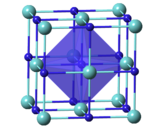Zirconium nitride
 |
|
| Names | |
|---|---|
|
IUPAC name
Zirconium nitride
|
|
| Other names
Zirconium(III) nitride, Nitridozirconium
|
|
| Identifiers | |
|
3D model (Jmol)
|
|
| ChemSpider | |
| ECHA InfoCard | 100.042.864 |
| EC Number | 247-166-2 |
|
PubChem CID
|
|
|
|
|
|
| Properties | |
| ZrN | |
| Appearance | Yellow-brown crystals |
| Odor | Odorless |
| Density | 7.09 g/cm3 (24 °C) |
| Melting point | 2,952 °C (5,346 °F; 3,225 K) at 760 mmHg |
| Insoluble | |
| Solubility | Soluble in concentrated HF, acids |
| Structure | |
| Cubic, cF8 | |
| Fm3m, No. 225 | |
|
a = 4.5675 Å
α = 90°, β = 90°, γ = 90°
|
|
| Octahedral | |
| Thermochemistry | |
| 40.442 J/mol·K | |
|
Std molar
entropy (S |
38.83 J/mol·K |
|
Std enthalpy of
formation (ΔfH |
−365.26 kJ/mol |
| Related compounds | |
|
Related refractory ceramic materials
|
Tantalum carbide Niobium carbide Zirconium carbide |
|
Except where otherwise noted, data are given for materials in their standard state (at 25 °C [77 °F], 100 kPa).
|
|
|
|
|
| Infobox references | |
Zirconium nitride (ZrN) is an inorganic compound used in a variety of ways due to its properties.
ZrN grown by physical vapor deposition (PVD) is a light gold color similar to elemental gold. ZrN has a room-temperature electrical resistivity of 12.0 µΩ·cm, a temperature coefficient of resistivity of 5.6·10−8 Ω·cm/K, a superconducting transition temperature of 10.4 K, and a relaxed lattice parameter of 0.4575 nm. The hardness of single-crystal ZrN is 22.7±1.7 GPa and elastic modulus is 450 GPa.
Zirconium nitride is a hard ceramic material similar to titanium nitride and is a cement-like refractory material. Thus it is used in refractories, cermets and laboratory crucibles. When applied using the physical vapor deposition coating process it is commonly used for coating medical devices, industrial parts (notably drill bits), automotive and aerospace components and other parts subject to high wear and corrosive environments.
Also zirconium nitride was suggested as a hydrogen peroxide fuel tank liner for rockets and aircraft.
...
Wikipedia
